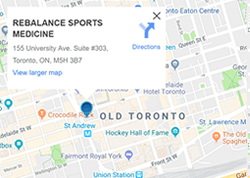Yoga Beneath the Surface
 “Yoga? But I’m not flexible!”
“Yoga? But I’m not flexible!”
This is a very common response I hear when I suggest yoga to my patients. There seems to be a common misunderstanding that in order to practise yoga one must be able to twist and turn into pretzel like shapes all the while maintaining a calm smile and long slow breaths. If you can maintain the calm smile and long slow breaths that is great but there is absolutely no pretzel-ing necessary! In fact the asanas (postures) are but one aspect of yoga in its entirety. Yoga itself is a philosophy developed to guide personal growth toward spiritual enlightenment. The physical yoga practised in the west is one of 8 steps in this process. Others include pranayama (breathing practise), pratyahara (turning inward), dharana (concentration), and dhyana (meditation). If you have ever done a yoga class you will likely recognize that these aspects tend to be interwoven throughout the class to varying degrees depending on the class, studio, and teacher. By moving your body into different, challenging, and sometimes awkward poses yoga shows you your edge – your physical limits. It is all about being patient with your body, respecting your body, and loving your body enough to embrace your current edge. This is where you are right now and that is okay! With consistent practise and patience you will be able to push that edge and go a little bit deeper. I am not talking about pretzel shapes here, but maybe going from being 6 inches away from touching your toes to 3 inches from touching your toes. If it is important to you and you put in consistent effort in a safe environment your body will respond by expanding its abilities.
Many of the known benefits of yoga align with the outcomes we aim for as physiotherapists: strength, flexibility, body awareness, range of motion, overall physical condition, balance, coordination and decreased pain. There is research linking yoga to increased flexibility, exercise capacity, body awareness, strength, balance and pain tolerance. There is also substantial research linking yoga to pain relief and the Canadian Institute for the Relief of Pain and Disability has designed a specific yoga program to aid in chronic pain management. Yoga has an added benefit of decreasing stress and anxiety. Many studies have investigated its link with the parasympathetic nervous system (our rest and digest system) and although it remains unclear whether it is the breath-work, postures or meditation that allows relaxation the studies consistently show that yoga enhances parasympathetic activity. In order to receive the maximum benefit from this amazing practise it is important to find a teacher/facility that fosters a safe environment and encourages each person to work at an appropriately challenging level for their body. Due to the physical nature of the practise there is a risk for injury in yoga as in any other physical activity.
Yoga can be an integral portion of a rehabilitation program and may even change your outlook on your body and your life.
Namaste-
Written By: Heather McNeil RPT, CYA-RYT 200
Rebalance Toronto
Rebalance Sports Medicine is a multidisciplinary clinic in downtown Toronto offering physiotherapy, chiropractic, registered massage therapy, sports medicine, naturopathy, Pilates and more.



 What to Expect From Your First Physiotherapy Visit
What to Expect From Your First Physiotherapy Visit The Benefits of Fascial Stretch Therapy [Demo]
The Benefits of Fascial Stretch Therapy [Demo] How Does Physiotherapy Work?
How Does Physiotherapy Work? Best Exercises for Low Back Pain
Best Exercises for Low Back Pain